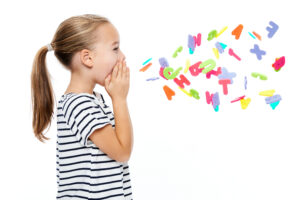How to handle your child’s stutter

Understanding the fundamentals behind stammering can help you get ahead of this issue and minimise the impact on your little one’s daily life.
Stuttering, also known as stammering, is a speech condition that affects the flow of speech, preventing children from speaking clearly and smoothly. Not only can this make it particularly challenging for them to express themselves, it presents issues when it comes to making new friends and fitting into the social hierarchy of their peers.
The root cause
Unfortunately, there is no definitive reason for stuttering in children. Some studies suggest that it’s a result of a miscommunication between their brain and the muscles in their mouth that are responsible for producing speech. A delay or misfire of this signal could easily lead to a stammer.
There are also genetic factors at play. Children who stutter tend to do so due to a gene that has been passed down to them by a parent. However, a parent or grandparent with a stammer doesn’t guarantee that the child will develop one. Surprisingly, it is believed that stress and anxiety cannot ‘create’ a stutter, although they can trigger or increase the severity of a stuttering issue that is already present.
Types of stuttering
There are three main types of stuttering: developmental, neurogenic and psychogenic. Let’s dive in!
Developmental
Developmental stammering is the most common kind. Usually appearing in children aged between two and six years old, it often passes within six months – but if it continues, it’s best to seek the help of a professional. Boys are more likely to develop a stutter than girls, and children who begin to stutter after three-and-a-half years of age are significantly more likely to continue.
Neurogenic
Neurogenic stammering can happen as a result of a brain injury or a stroke. Here, the speech signals from the brain may be erratic and produce speech issues.
Psychogenic
Psychogenic stuttering is rare and is usually seen in someone who has experienced a deep, emotional trauma that leads to the sudden presentation of a stammer.
The symptoms
Generally, stuttering takes place at the beginning of a sentence and it may be accompanied by a physical expression, such as a frown or a series of blinks. If you’re unsure whether or not your child is stammering, there are a few clear signs. This speech issue can manifest as part-word repetitions, single-syllable word repetitions, prolonged sounds, or blocks and stops.
Part-word repetitions
Part-word repetitions are primarily where a child will seemingly get stuck on the first letter of a word, and keep repeating it until they complete the word or stop entirely, out of frustration.
Single-syllable word repetitions
If your little one is repeating entire single-syllable words in a stuttering fashion, it’s likely that they’re experiencing a form of speech disfluency.
Prolonged sounds
Stuttering also comes in the form of prolonged sounds. The speaker may appear to freeze on a vowel or consonant sound, dragging it out much longer than usual.
Blocks or stops
The fourth type of stammering is an absence of speech, known as blocks or stops. In the lead up to saying a part of a sentence, your child may hesitate as they try to get the word out to such an extent that there is a noticeable pause or break in the sentence.
Other disfluencies
There are plenty of speech disfluencies that many of us experience that aren’t related to stuttering. Repeating whole, multi-syllable words or phrases is something that virtually everyone does from time to time, whether it’s due to a hesitation in the middle of a sentence or a distracting thought entering your mind.
Similarly, interjections such as ‘um’, ‘em,’ or ‘eh’, are also normal parts of conversation as children form thoughts while they speak. The same is true with revisions, where your little one might say one word and then another word to more accurately describe what they’re trying to say. None of these are standalone symptoms of stuttering and shouldn’t really cause any concern.
Social effects
As a parent, it’s only natural to worry about the social knock-on effects that your little one might experience if they stammer. Let’s take a look at how it can play out, depending on their age.
Toddlers
Lots of toddlers who stutter don’t even realise that they’re doing it. This is actually a good thing as it’s less likely to inhibit them socially. With just as much confidence as the next child, they will try to make friends, speak up in class and generally interact with those around them.
Children
If your little one is still stuttering in primary school, the situation may change. They will now be aware that the manner in which they speak isn’t the same as all the other kids, and the other students will have noticed that too. This can foster a sense of embarrassment in the child who stammers, leading to them getting less involved in class and possibly beginning to retreat socially.
They may be judged by their peers as less capable and some might even get picked on. It’s important to keep the lines of communication open with your child and their teacher, to make sure that your little one isn’t experiencing any negative treatment in school.
Teenagers
If you have a teen who stutters, be aware that they may suffer with low self-esteem and a general lack of confidence. Being a teenager can feel excruciatingly awkward at the best of times, so a stutter is a very unwelcome addition. Let your child know that you are there and try to coach them through any social situations they may be daunted by.
Testing and treatment
Thankfully, there are professionals who are skilled in the arena of helping children to stop stammering – and early intervention is key. If you are concerned that your child has speech disfluencies, and they have had these for at least six months, then contact your local speech and language therapist.
Evaluation
Initially, the speech and language therapist will examine your child’s specific case and make a determination on their condition. They will take various aspects into account, such as which type of stutter the child experiences, how they react when they stutter and what coping mechanisms they have to attempt to move past a stammering point. The SLT will combine this information to understand whether or not your child has a stutter, and how exactly theirs manifests itself.
Treatment
The recommended treatment route hinges on factors that vary from child to child. Among these are your little one’s age, how often and to what extent they stutter, how they react to their own stammering and how those around them react too.
Direct and indirect strategies can be used to help your little one overcome their stutter. By tackling the issue explicitly with your child, the direct approach focuses on how they speak and provides them with tools to overcome obstacles in their speech. An indirect approach supplements a direct approach well, particularly with more anxious children, as it is carried out without the child realising. Indirect strategies include parents slowing down their own speech and removing the pressure for their little one to respond to them quickly. This environmental adjustment will go some way to removing the stress and anxiety that your child may feel, and therefore improve the symptoms of their stutter.
Standing out from the crowd is the last thing many children want, and a stammer is a difficult ordeal for even the most resilient child. The good news is that most kids stop stammering by themselves by five years of age. With more insight into the issue and with the help of a professional, you will be able to find out if your child’s stutter is something to be concerned about and how to proceed with treatment. Once on that path, your little one will be able to focus on what really matters – enjoying their childhood and growing into the unique individual they were born to be!
Image Credit: Shutterstock











Comments